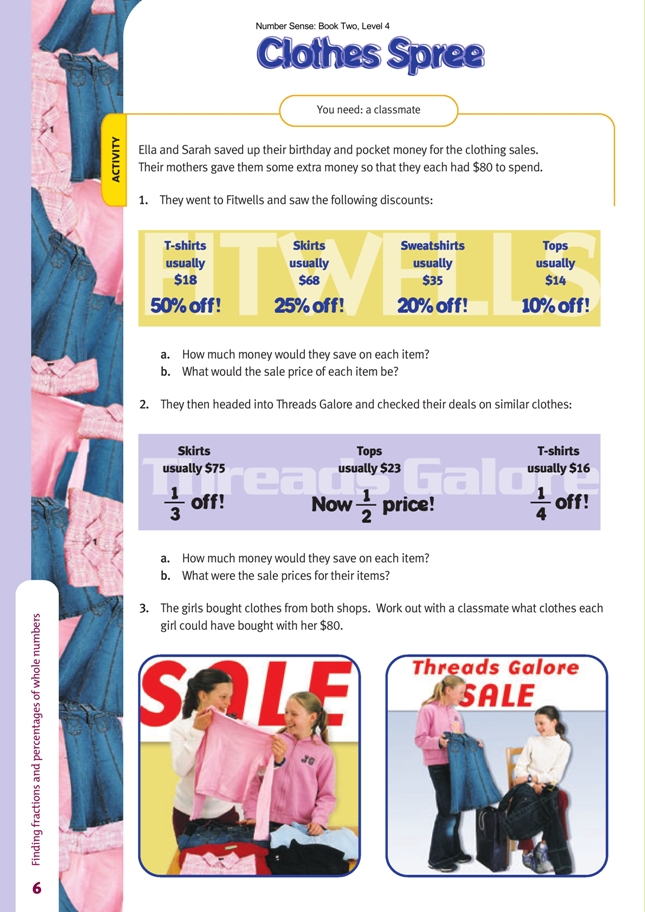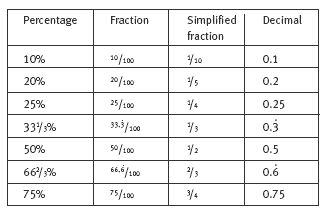This is a level 4 number activity from the Figure It Out series. It relates to Stage 7 of the Number Framework.
A PDF of the student activity is included.
Click on the image to enlarge it. Click again to close. Download PDF (697 KB)
find percentages of whole numbers
find fractions of whole numbers
A classmate
The questions in this activity can be tackled with greater understanding if the students are able to easily change percentages into fractions and vice versa. It is also likely to be helpful if they know the decimal equivalents. Given such understanding, all the questions can be done mentally, and it is probably wise to encourage the students to do so. At the same time, the questions also provide opportunities to learn some
efficient ways to use a calculator to solve problems of this kind. This reinforces the idea that percentages are nothing more than special sorts of fractions, that is, fractions with a denominator of 100. Suggestions for how this might be done are provided below.
First, though, consider the value of being able to change percentages into fractions. If the students know that 50% is half, in the first item of question 1 they just need to take half of $18 (that is, $9). For the remainder of the items in this question, they need to know (or be able to work out) that 25% is one-quarter, 20% is one-fifth, and 10% is one-tenth. It may be useful to put aside the problems temporarily while the students construct a chart of the fraction and decimal equivalents of common percentages. A further advantage of doing this is that the students can learn how to work out the fraction equivalents. This means that if they forget what some are, they are in a position to figure them out on their own.
Working out such fraction equivalents is basically a matter of simplifying fractions. For example, 25% means 25 out of 100, and can be written as 25/100. This simplifies to 1/4 through dividing both the top and bottom by 25, or alternatively by dividing the top and bottom by 5 and then 5 again. Mathematically, it is the identity
principle at work because the fraction is effectively being divided by 1 in the form of 25/25. Similarly, 50% can be written as 50/100 and simplified to 1/2. A completed chart may look like the following:
You could give the students the chart with only one figure in each row and ask them to complete it.
A decimal column has been added to the chart because the decimal equivalent provides yet another way of calculating prices when a percentage or fraction has been taken off.
There are two main ways of calculating discounts or sale prices using a calculator. The quickest way to calculate the discount on the skirts that have been reduced by 25% is to key in 68 x 25 % , and the calculator immediately gives 17 (that is, $17). It is not necessary to key in = . To find the sale price, you subtract the discount ($17) from the full price ($68) to give $51. The quickest way to calculate the sale price
directly is to reason that if there is 25% off, the sale price must be 75% of the original price, so key into the calculator the following: 68 x 75 % . This immediately gives 51 (that is, $51).
The second approach is to use the decimal equivalent. Thus, with the same example, simply key in 68 x .25 = , and once again the calculator gives 17. Similarly, to find the actual sale price, key in 68 x .75 = , and the result of 51 is displayed.
When the students come to question 2, they need to realise that, in the case of the skirts, $75 can be thought of as 3 lots of $25 (which means that one-third of $75 is $25) and, in the case of the tops, the result is not going to be whole dollars (because half of $23 is $11.50).
Finally, question 3 is an interesting investigation involving comparisons of the discounts offered by the two shops and the challenge of working out what would be the best buys. Different pairs of students are likely to devise different solutions, which they can share with classmates. This will inevitably include sharing their mathematical reasoning. It may also include a discussion of whether sale items are the best value for money.
Answers to Activity
1. a. T-shirts $9
Skirts $17
Sweatshirts $7
Tops $1.40
b. T-shirts $9
Skirts $51
Sweatshirts $28
Tops $12.60
2. a. Skirts $25
Tops $11.50
T-shirts $4
b. Skirts $50
Tops $11.50
T-shirts $12
3. Answers will vary. Two possibilities are:
Skirts (Threads Galore) $50
Three T-shirts (Fitwells) $27
$50 + $27 = $77
or
Three T-shirts (Fitwells) $27
Two tops (Threads Galore) $23
Sweatshirt (Fitwells) $28
$27 + $23 + $28 = $78

